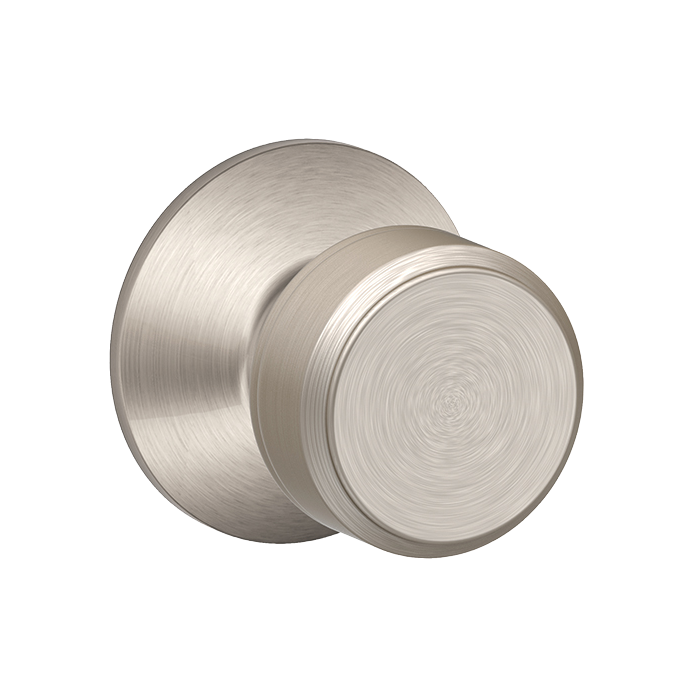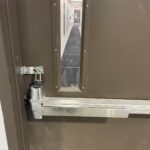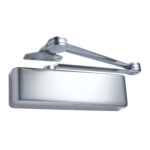For most types of buildings, lever-handle locksets are standard equipment, but some existing buildings may be equipped with knobs. Are knobs acceptable by code in existing health care facilities?
The answer to this “quick question” is multifaceted, so I’ll break it down. Here goes…
 There are two accessibility standards that are widely used in the US – ICC A117.1-Accessible and Usable Buildings and Facilities and the 2010 ADA Standards for Accessible Design. According to these standards, operable hardware installed on doors that are part of an accessible route is required to be operable without tight grasping, pinching, or twisting of the wrist. Knobs typically require tight grasping, pinching, and/or twisting of the wrist, and therefore they do not meet these requirements. The next question is…are health care facilities required to comply with the requirements of these accessibility standards?
There are two accessibility standards that are widely used in the US – ICC A117.1-Accessible and Usable Buildings and Facilities and the 2010 ADA Standards for Accessible Design. According to these standards, operable hardware installed on doors that are part of an accessible route is required to be operable without tight grasping, pinching, or twisting of the wrist. Knobs typically require tight grasping, pinching, and/or twisting of the wrist, and therefore they do not meet these requirements. The next question is…are health care facilities required to comply with the requirements of these accessibility standards?
The International Building Code (IBC) includes the no-tight-grasping/pinching/twisting requirement for doors that are required by to be accessible per Chapter 11. The 2015 edition of the IBC requires almost all types of buildings and facilities to meet the requirements of ICC A117.1, with 14 exceptions.* Although some of these exceptions could apply to a specific area within a hospital (for example, a walk-in cooler), the exceptions do not exempt health care facilities in general. Therefore, a building that was built in accordance with the requirements of the IBC would require hardware that can be operated without tight grasping/pinching/twisting (and would not have knobs). But what about existing buildings that were built prior to the IBC, or in jurisdictions where the IBC has not been adopted?
For questions related to existing health care facilities, I would typically turn to the 2012 edition of NFPA 101 – Life Safety Code, because that is the code currently adopted by CMS** and used by accrediting organizations like the Joint Commission. NFPA 101 references ICC A117.1 in Chapter 2 – Referenced Publications, so at first glance it may appear that NFPA 101 requires door hardware to comply with ICC A117.1. BUT…it’s important to note that the inclusion of a particular standard in a model code’s list of referenced standards does not necessarily mean that every part of the standard applies.
For example, NFPA 101 references ICC A117.1 in several locations, but almost all of the references are related to signage, with a couple of references to two-way communication systems and stair nosings – these would have to comply with ICC A117.1. The code does define an accessible route as “a continuous unobstructed path that complies with this Code and ICC/ANSI A117.1,” but then exempts fully-sprinklered health care occupancies from the requirements for an accessible means of egress (“7.5.4.1.3 Accessible means of egress shall not be required in health care occupancies protected throughout by an approved, supervised automatic sprinkler system in accordance with Section 9.7.”). Although NFPA 101 does include a reference in Annex A to hardware that is operable without tight grasping/pinching/twisting (“The operating devices should be capable of being operated with one hand and should not require tight grasping, tight pinching, or twisting of the wrist to operate”), I don’t see a mandatory requirement in NFPA 101 that would prevent the use of knobs on existing health care facilities that are protected throughout by a sprinkler system.
BUT (another “but”)…what about the Americans with Disabilities Act (ADA)? This federal law does apply to most health care facilities, and the 2010 ADA Standards for Accessible Design do require operable hardware that requires no tight grasping/pinching/twisting. So my answer to this QQ is – if a health care facility is required to comply with the 2010 ADA Standards for Accessible Design, knobs would not be compliant. While the Joint Commission may not be addressing existing knobs and there may not be a team of “ADA inspectors” checking existing health care facilities for compliance, it’s possible that a facility could be cited for non-compliance with the ADA based on a complaint. Some existing knobs may pre-date the ADA requirements, but these facilities may be required to remove the barrier of non-compliant hardware if doing so is feasible, or to accommodate people with disabilities by alternative means.
Agree? Disagree? Had experience with this issue? Tell us!
* If you want more information on these 14 exceptions, I will write a separate post about that.
** CMS is the Center for Medicare and Medicaid Services.
You need to login or register to bookmark/favorite this content.





I recommend medical facilities to retrofit knobs to levers to be ADA compliant due to the fact that most medical facilities have injured or sick patients that do not have full use of their fingers that could not turn a knob. Anyone can try this exercise at home where you try to turn a knob without the use of your fingers (ball up your hands into a fist) and it is pretty difficult. It could be life threatening in a case of emergency egress.
So….health care facilities don’t have to comply with federal law (ADA)??
I guess my question would be why would any health care facility want to install knobs? They are in the business of serving the disabled….
Unless I’m losing it (which is possible) I think I wrote that most health care facilities DO have to comply with the ADA.
– Lori
An important thing to also note with regard to ADA for existing buildings is that it addresses spaces for “public accommodation.” A compromise to replacing ALL hardware could be to replace hardware at rooms the public will use (i.e. entrances, exits, restrooms, waiting rooms, examination rooms, etc) and not at all your support spaces (mechanical rooms, electrical rooms, storage closets, etc).
I may be losing it as well… more likely than you 🙂
My point was really, why would any healthcare institution not want to comply???
The ADA level of compliance should have been done a long time ago as it was intro in the early 1998 BC Fire Codes level.–Yes that’s in Canada.
I put this part of a full page report in the National Locksmith Ledger years ago to start the intro to this system.
Keep up the great work Lori and thanks again for all your hard long hours of work.
The B.C. Fire Code is essentially a set of minimum requirements respecting fire safety in existing buildings and within the community at large. Its primary purpose is the promotion of public safety through the application of uniform fire safety standards throughout British Columbia.”
APPENDIX A “A-5-2.1.5.3- The operating devices should be capable of being operated with one hand and should not require tight grasping, tight pinching or twisting of the wrist.”
FIRE CODE 101-29: 5-2.1.5.3 Latch or other fastening device on a door shall be provided with a lever knob, handle, panic bar, or other simple type of releasing device having an obvious method of operation under all lighting conditions. The releasing mechanism for any latch shall be located not more than 48”. (122cm) above the finished floor. Doors shall be operable with no more than one releasing operation.
B.C. BUILDING CODE REVISIONS 19953.3.1.12.3C
“be operated by devices which do not require tight grasping, or twisting of the wrist, as the only means of operation.”
I would like to say that knobs cannot be given on the doors for health care facility even on an existing one since it affects the single motion to retract the latch in case of any emergencies and in an health care since the patients are mostly sick, using a knob to retract the latch could cause a lot of trouble in terms of twisting and pinching. And also round door knobs could present a safety risk for ligature if they were located in an area where behavioral health patients are located.
And door knobs are not ADA compliant as well.
The International Building Code is applicable in new building. Once a certificate of occupancy is issued the IBC is closed. The NFPA 101, NFPA 80, and NFPA 105 becomes applicable for enforcement.
CMS uses the Life Safety Code and applicable reference to other codes. In behavior health facilities one must consider ligature hazards.
I think that knobs are not acceptable by code in health care facilities since in order to make the opening compliant to the accessibility standards, the opening should be operable without tight grasping, pinching, or twisting of the wrist. This is not the case with door knobs which do require a tight grasp and twisting.
However, if a certain facility is constructed or has adopted a version of the code in which this condition was not a requirement, the knob in those facilities may be permitted on openings.
So, although the knobs are acceptable by code, the facility should upgrade to and retrofit the knobs to lever handles in order to make it easier of everyone to use the opening comfortably and thus be acceptable by the people.
What are the 14 exceptions? I searched around your site but couldn’t find a post on this even though I recall reading one.
Here you go! http://idighardware.com/2017/11/ibc-accessibility-exceptions/
– Lori